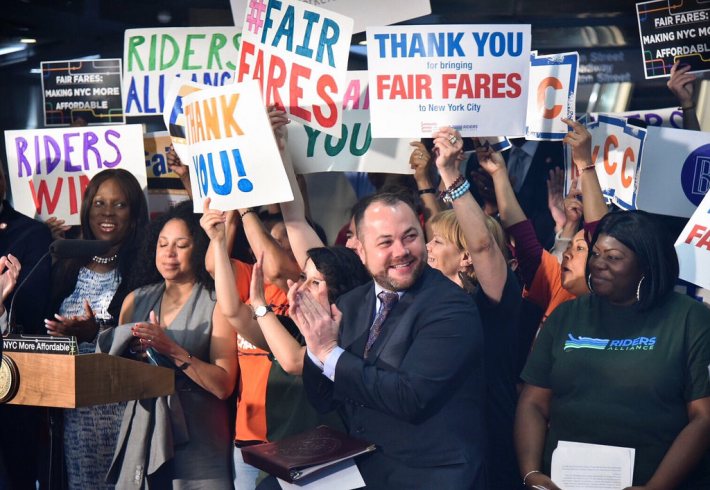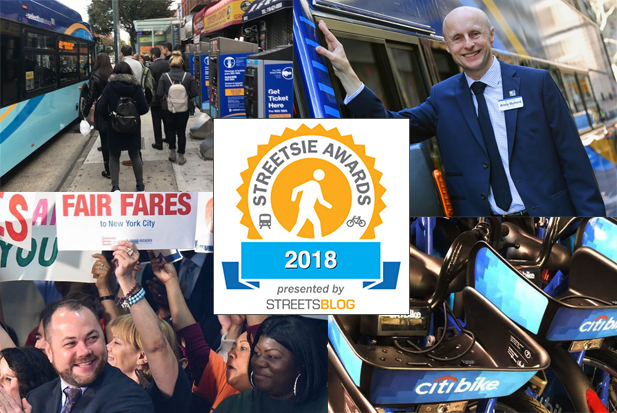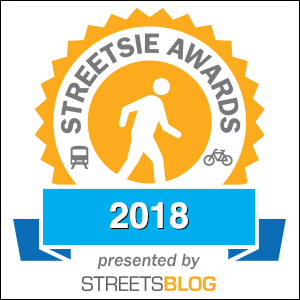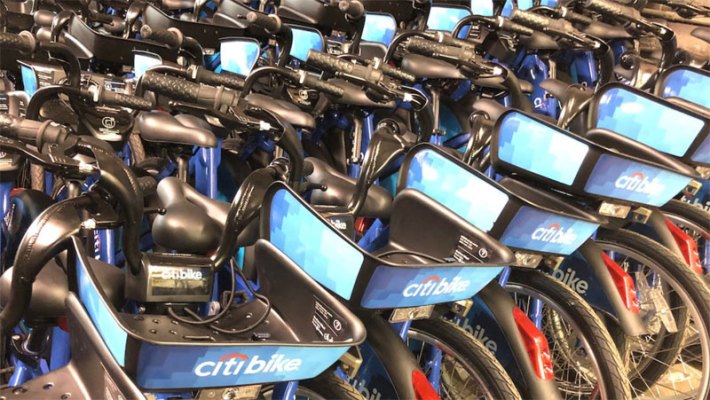Transit: It's not just about trains.
As Streetsblog readers know, our streets must play a vital role in carrying New Yorkers as the city continues to grow. The subway's unfunded repair bill is anywhere between $41 and $60 billion. So since it's obvious we can't count on much future subway construction, our streets hold the key to our transit future.
Yet those streets, the largest swath of publicly owned land we have, are almost entirely devoted to privately owned single-occupancy vehicles.
The result: gridlocked commercial centers — Midtown Manhattan, Lower Manhattan, downtown Brooklyn, Jamaica, the Hub, and others — are having a domino effect on the rest of the city, causing a total collapse in bus ridership.
Fortunately, the city Department of Transportation and the MTA (and the NYPD to a lesser degree) are doing something to take the streets back for transit. Here's a review of the most exciting attempts of the year:
B82 Select Bus Service

At some points this year, it wasn’t entirely clear B82 SBS would ever launch. The project — which laid down bus lanes on stretches of Kings Highway where buses previously crawled at less than 5 mph — sped up service for 28,000 daily riders.
Yet it was fiercely opposed by a bipartisan cadre of elected officials, who dragged MTA and DOT officials through months of meetings to "win" back 34 rush-hour parking spots from the original plan.
It’s the exact type of “stand-off” MTA buses and subways chief Andy Byford told council members earlier this month he wants to avoid.
“Being blunt: the Fast Forward plan will grind to a halt if … we have to have a six-month stand-off at every single installation,” Byford said on Dec. 4.
Bus Action Plan

Of course, for all we know, southern Brooklyn’s B82, which runs east-west mostly on Kings Highway, could be the last Select Bus Service project ever (except for 14th Street SBS set to launch ahead of the L train shutdown). Advocates would certainly be happy about that — they’ve been pushing the city and MTA to expand the SBS toolkit to all the city’s bus routes. And the MTA seems to agree, having pushed back funding for new SBS projects until 2021.
Enter Byford’s “Bus Action Plan,” which he unveiled in April to significant acclaim. The multi-pronged plan drew on every single idea proposed by the Bus Turnaround Campaign since the summer of 2016, and set timetables for each: tap-and-go fare readers by 2020, a total overhaul of the bus network by 2021, and increased off-peak service on certain routes, which began rolling out this year.
That effort got underway in earnest this fall with a series of public workshops in the Bronx. City Council members, however, have been MIA on bus service — even as the city stands to play a crucial role
Fair Fares

After two years, the Riders Alliance and Community Service Society-led coalition finally won half-priced Metrocards for low-income New Yorkers — thanks to a closing effort by City Council Speaker Corey Johnson. Mayor de Blasio insisted the state should foot the bill, but Johnson saw an obvious win in a program broadly supported by his members.
Of course, none of that was possible without two years of persistent advocacy by Riders Alliance and Community Service Society, who managed to convince a large council majority that the city should help its working poor afford to get to work, as it does for its students and seniors.
Unfortunately, the status of that victory is currently in flux: As of writing, the city has yet to put out any information on how the public can access the half-priced transit cards, which were supposed to launch at the start of 2019 — in four days!
And the city, which never wanted to operate the program in the first place, is limiting the discount tickets to monthly and weekly cards.
Citi Bike Expansion
Citi Bike, well, Lyft, agreeing to spend $100 million to expand its fleet was yet another long-sought goal of advocates achieved in 2018.
Details remain murky — subject to a top secret contract between the city and Lyft — but so far we’ve been told we’re getting three times as many bikes covering twice as much territory.
That's a huge boon for NYC bike-share, which has proven wildly successful and has become a real public transit option in the neighborhoods it serves.
Of course, Citi Bike faces a reliability crisis, marked by Streetsblog’s discovery in September that 41 percent of its bikes were out-of-commission — a lot of pressure is on Lyft to show it can turn things around in the New Year.
The winner...
Nothing gets Streetsblog more excited transit-wise than the Bus Action Plan — and an actually useful bus network running on wide-reaching and widely-respected (and enforced) bus lanes. Nothing.








